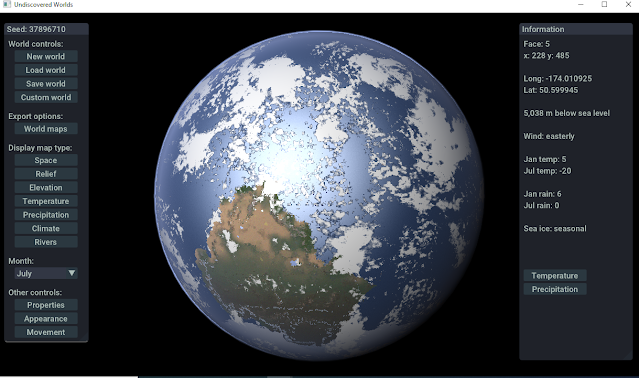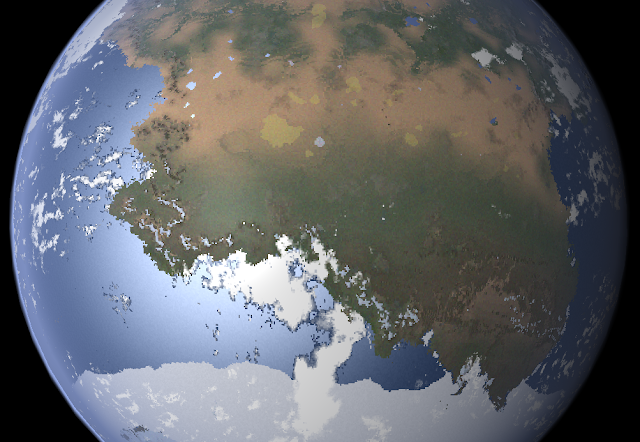Translating my simulations into a spherical context has thrown up an issue that I've had at the back of my mind for a while: how to represent changes over an annual cycle? The colours on relief maps that Undiscovered Worlds creates are determined by rainfall, temperature, and so on, but it always draws the maps on the basis of annual averages. But the program does track variations in these things from month to month. So I've thought for some time it would be interesting to add the ability to generate monthly maps, so you could see, for example, the advance and retreat of the ice caps over the course of a year.
Now that I'm dealing with properly spherical worlds rather than flat maps, doing something about this has rather been forced upon me, because if I'm displaying the world as a sphere in space, with light coming from a particular direction, I need to make sure that it's the correct direction, based on the planet's orbital characteristics. But that will vary throughout the year. In other words, to display the world at all - at least in the pseudo-realistic fashion that I've been developing - I have to make a decision about what time of year it is. And that suggests (a) that the features on the world, such as sea ice, should reflect that time of year, and (b) that it should be possible to change the time of year and see how these things change.
So I've implemented this now. You can change the month, which will affect things such as the sun's angle and distance, the extent of ice on sea and land, how arid or lush the land appears (monsoon areas look desert-like in the dry season and green in the wet season), and even how big rivers are (they swell and dwindle to reflect precipitation, and can also show flooding in times of thaw). Cloud cover can also vary depending on precipitation, although it doesn't change otherwise.
For example, here is a world shown in January:
And here is the same world in July:
You can see how the features have changed to reflect the seasonal changes. Also note that the camera angle remains constant even as the planet shifts relative to the sun - you can set the camera to remain in the same place relative to the planet when making these changes, or you can detach it and watch the planet rotate beneath you.
Here is a more zoomed-in series of shots of another world, showing the changes month-by-month from January to July. I especially like how you can see the snow creeping down the mountains as winter approaches. Notice also how the bit of land in the bottom left-hand corner has a fringe of sea ice around it all year round - this is from the sheltering effect of the land itself, which encourages ice to form in temperatures where it wouldn't be possible in more open ocean. The same effect causes the ice cap to seem to reach up slightly towards the main continent as it moves north in the colder months.










No comments:
Post a Comment